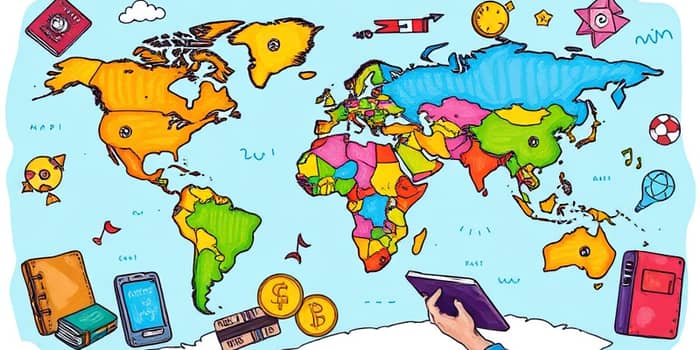Travel opens doors to new cultures and unforgettable memories, but unsound money management can turn a dream trip into a financial headache. This guide equips you with practical strategies for lasting freedom and real-world tactics to budget, save, and thrive both on the road and back home.
Determining Your Financial Situation and Setting Goals
Before booking tickets, take stock of your current finances. Create an inventory of income, expenses, debts, assets, and recurring commitments. Understanding where you stand is the foundation for success.
Next, set specific travel goals. Are you planning a weekend city break, a yearlong gap adventure, or transitioning to a digital nomad lifestyle? Define milestones like saving $5,000 for a Southeast Asia trip or covering six months of living expenses abroad.
By mapping out clear targets, you transform vague aspirations into measurable and motivating objectives that guide every financial decision.
Budgeting for Travel
Crafting a comprehensive travel budget requires analyzing every potential cost. Start by listing major categories and estimating realistic expenses.
- Flights and ground transport (trains, buses, taxis, rentals)
- Accommodation (hostels, hotels, home exchanges)
- Food and beverages (groceries, restaurants, street snacks)
- Activities and experiences (tours, museums, entertainment)
- Visas, permits, vaccinations, medication
- Baggage fees, travel insurance, phone/internet
- Miscellaneous (souvenirs, tips, toiletries)
Always include a five to ten percent buffer for unexpected costs. Research cost-of-living sites to compare daily rates and refine your estimates.
Convert your budget into a dynamic spreadsheet or use apps to track spending. Reviewing actual costs daily helps you stay on course and detect overspending early.
Saving for Travel: Strategies and Accounts
Open a dedicated travel savings account at a bank offering competitive interest and restricted ATM access. This prevents impulse withdrawals and drives growth.
Automate regular contributions each month to ensure saving never takes a back seat. Whenever you receive a bonus or earn extra from a side gig, funnel a portion into this fund to accelerate progress.
Embrace the pay yourself first mantra by treating your travel fund as an essential bill. Automating deposits means you never forget and you prioritize experiences over last-minute shopping sprees.
Managing Finances on the Road
Before departure, set up automatic bill payments for recurring charges such as rent, utilities, and loans. This ensures your obligations are met without interruption.
Notify your bank and credit card companies of your itinerary to avoid fraud alerts that could freeze accounts. Carry multiple cards stored separately as a fail-safe.
Use robust mobile banking apps to monitor balances, transfer funds, and block cards instantly if your wallet is lost or stolen. These tools empower you to resolve issues from anywhere in the world.
Dealing With Debt and Financial Obligations
Assess any fixed assets you leave behind. Renting or subletting property can generate income, while long-term storage solutions protect belongings.
If possible, pay down high interest debt before departure to minimize carrying costs. For longer trips, negotiate payment plans or refinance loans to secure lower rates.
Set up a minimum payment plan while away to avoid late fees and protect your credit score. Automating these payments keeps you in good standing without ongoing oversight.
Smart Use of Credit Cards and Handling Currency
Select travel-friendly cards with no foreign transaction fees, robust rewards, and built-in fraud protection. Research ATM partnerships to withdraw cash cheaply.
Always choose payment in the local currency to avoid dynamic currency conversion fees. If offered a choice, paying in euros or dollars often triggers unfavorable exchange rates.
Maintain a small stash of backup cash in major currencies and hide it separately from your wallet. This emergency buffer fund at all times ensures you remain liquid during crises.
Tools and Apps for Financial Management While Traveling
Modern travelers have an arsenal of digital tools at their fingertips. Use these apps to plan, monitor, and optimize every dollar spent.
- Budgeting: Mint, YNAB, Pocketguard, TravelSpend
- Cost Research: Numbeo, BudgetYourTrip
- Flight Search: Google Flights, Skyscanner, Hopper
- Banking: Global online banks, multi-currency accounts
- Insurance: Comparison platforms for medical and evacuation coverage
Ensure your chosen services allow instant card blocking and limit international withdrawal fees. This flexibility is crucial for financial resilience while exploring new horizons.
Handling Emergencies and Unexpected Expenses
No amount of planning can eliminate surprises. Secure comprehensive travel insurance that covers medical treatment, trip cancellations, and theft.
Keep a secondary cash reserve and always check policy details for high-risk activities. A well-funded emergency pool shields you from unplanned costs without derailing your journey.
Post-Travel Financial Health
Upon return, compare actual spending against your original budget. Analyze variances to refine future estimates and improve accuracy.
Replenish your travel savings account immediately if another adventure is on the horizon. Document lessons learned about overspending triggers and smarter cost-saving habits.
Address any outstanding debt incurred on the road promptly. Settling balances quickly avoids accumulating interest and resets your foundation for the next exciting chapter.
References
- https://www.quicken.com/blog/financial-planning-tips-all-travelers-should-consider/
- https://www.nerdwallet.com/article/travel/saving-money-on-travel-tricks
- https://beaumondetraveler.com/content/financial-advice/
- https://www.theprofessionalhobo.com/managing-your-money/
- https://travelmugpodcast.com/balancing-personal-finance-and-travel/
- https://www.investopedia.com/how-to-travel-on-a-budget-8655623
- https://www.investopedia.com/articles/personal-finance/100516/setting-financial-goals/
- https://www.nerdwallet.com/article/finance/personal-finance










